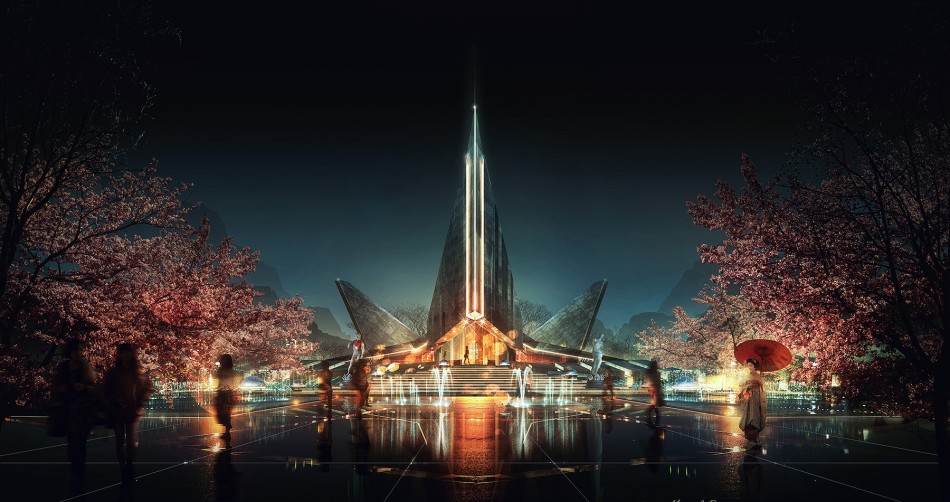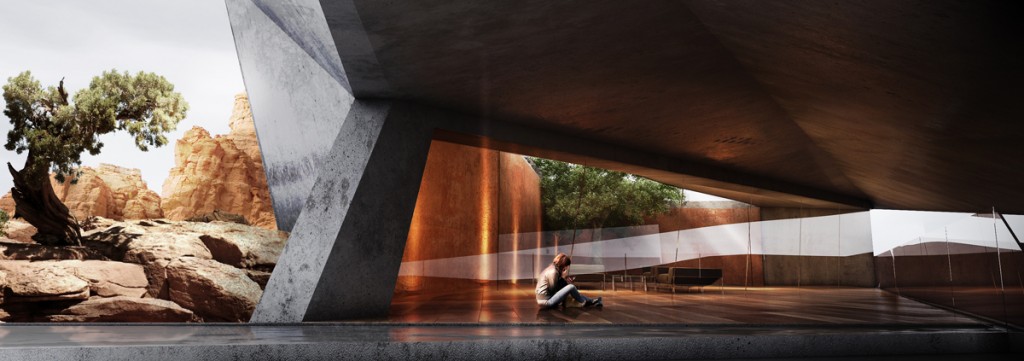Without having any hard numbers to share, just speaking from observation, but I think that for a lot of people in this industry it first starts as a hobby and only later it become a profession and a lifestyle (pizza, Red Bull & 3D). And for those artists who an architectural background, oftentimes their “primal” profession, architecture, becomes a hobby.
How about you- what came first for you – the egg or the hen? Did you spend many sleepless nights trying to solve the teapot mystery [the famous 3ds max primitive]?
I believe you are 100% correct. In my case I’d always really enjoyed the creation process that architecture enables us to develop. I remember how amazing it was to build the physical model and then translate it into a view that I could easily manipulate in 3D or other on the computer.
“I never looked back, it became second nature, I got to do the part I loved the most, which was to participate on the concept design phase.”
Initially I went on to become a professional architect working for myself, although everything was going well, I always felt the urge to develop more my creative process and 3D started to occupy more and more time within my workload, until I made the switch completely…I never looked back, it became second nature, I got to do the part I loved the most, which was to participate on the concept design phase. It was incredible I was living 15 minutes from the beach, surfing, working for around the world and generally enjoying the good life as you may say, a perfect set up no? Not so for me, I found the more imagery I “consumed” the more I wanted to learn, the more I wanted to develop, thus then moving to London, where as you may know I got the chance to have my mind blown away at Vyonyx!
Today architecture still has a big part in my life, but these days I either take small commissions or not even a commission and just build on site with builders for friends and family. I tell my friends to pay me in beer and let me enjoy the greatest part of all which is to think about architecture and how we live (since the majority of works are dwellings), they can easily find an architect to take care of the project and I can review with them and see what works for their lives – that’s architecture for me these days and it’s the best it’s ever been.
There is this interesting thought by Picasso – “art is the lie that tells the truth.” In the commercial reality of our industry, would you say that Picasso’s words are still valid today or, rather the opposite – art (and archviz) is the truth that tells a lie?
Who am I to doubt Picasso! Funny thing I once wrote a small thesis in Uni, (which received a really bad grade mind you) which kind of touched on this subject.
As I’ve progressed through this field and gained more experience, I see that so too has my perception of art – truth/lies evolved with it. Once a believer that a “beautiful” image that focused on great colours, dark moods, lots of contrast and all the formal rules of beauty was all that was needed to convey an artistic experience, I now see that there is much more to this – our field is based heavily on perception– that which may seem simple and basic has a lot going on under the surface, similar to a duck in water – calmness above the water level whilst kicking feat like crazy underwater to gain momentum.
The line between truth and lie is a tenuous one in art. In example we represent a building located in imaginary cloudy and polluted city somewhere in the world in all its glory, focusing on the relationship between the various built forms, the landscape and also its geographical, ecological and situational concerns, through colours, light and form. It turns out to be something of a beautiful image, great composition, our eyes and soul absorb it like no other, it is true to the local, to the feeling of the building and its surroundings – we show it to the client – client loves it, promoter doesn’t – comments – to dark and moody, please make it with a blue sky, greens and happy.
This meteorological event would happen once every 5 years in this imaginary part of the world, however if only for that day, for that perception that is to be, it needs to be like that for whatever economical/artistic/autoristic reasons.
This isn’t necessary a lie, nor is it the truth, however it is possible to represent these things under idealistic representations of reality, tho it is our job to relay these intentions with art.
Back in 1962 D.J. Boorstin in his provocative book “The Image” was saying exactly that! That “advertiser’s art …consists largely of the art of making persuasive statements which are neither true nor false”. Maybe what we do should not be classified as art at all and ,maybe, we should accept the fact that we are mere advertisers of real estate? There are archviz companies out there that probably are smart enough to have (re)branded themselves as “creative communications agencies” which is probably what we are.
If we couldn’t be classified as art that would be no fun at all. This question could lead into a very deep rabbit holes of what is art and how it could be defined, I will be cautious to not go so far as I believe that there are many that know much more and rather better than I do on the subject on this occasion.
One recent article has come to mind whilst reading this question and I think it’s the perfect example of this dichotomy we are discussing – the article in on Peter Lik the famous landscape photographer and also one hell of a business man:
He is a good reflex of art – business – branding and how these limits are becoming harder and harder to distinguish – his photographic work has sold all over the world and he has regular prints with a value of £20K plus, as well as having sold in a private sale what is said to be the most expensive photograph ever recorded in a private sale $6.5 million. I believe he has turnover something like $500 million if I’m not in error.
That’s crazy! One thing that strikes most in that article, after all those difficult numbers is, quote, “the buyers of Lik’s work are also characterized as people with money to spend but very little understanding of fine art and the true value of what they’re purchasing.” In comparison, digital art is like a beggar trying to catch up with Photography’s sporty Phaéton…Phantom. In these times of mechanical reproduction we live in, is there a chance we will ever see collectors queuing in front of a digital artist’s shop to buy something that does not possess a “oneness”?
A hard one to answer, as I see it why not, people line up for anything these days, so why not line up for some top archviz art? If it were so easy and facilitated to replicate why do see the top firms delivering ever so amazing work that still astounds and clients paying top range prices for these types of work, isn’t that in itself an exemplification of what we are talking about? Clients paying for a masterpiece of archviz? It was created and distributed all over the internet, but it has a special purpose and meaning to those who commissioned, so who knows one day we may have a visual on demand shop?!
Architectural visualisations is a genre that obeys certain rules of conduct where, unlike advertising or film, everything negative and dangerous has been expelled or censored and this in a way narrows the spectrum of emotions we can evoke in the viewer only down to the ones used by the creators of romantic comedies. What are the elements in an image that help you build a narrative? Are these stories merely snapshots of a daily care-free life or they can carry a deeper existential meaning?
The elements of the image that really help it are without a doubt are the entourage (i.e., people cars, dogs, flowers, tea sets etc etc). These help humanize and liven the scene, especially in what is a “run of the mill happy day”. The imperfections contained within the images and jpgs overlaid or applied onto a harsh out of the oven render really help bring the image together.
“You can start to build little micro stories within your scene and much like a painter you start to look into relationships and stories that happen within, nothing should be there for the mere sake of just having it there, but should be compliment to the narrative.”
You can start to build little micro stories within your scene and much like a painter you start to look into relationships and stories that happen within, nothing should be there for the mere sake of just having it there, but should be compliment to the narrative.
These can of course carry a deeper existential meaning or little “Easter eggs” that you or the more attentive may spot.








Pingback: Arqui9 Interview featured in Gobotree - Arqui9 VisualisationArqui9 Visualisation